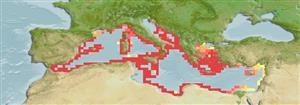Common names from other countries
Environment: milieu / climate zone / depth range / distribution range
Écologie
; profondeur 125 - 200 m (Ref. 2754). Subtropical
Distribution
Pays | Zones FAO | Écosystèmes | Occurrences | Introductions
Endemic to the Mediterranean Sea.
Length at first maturity / Taille / Poids / Âge
Maturity: Lm ? range ? - ? cm Max length : 120 cm SHL mâle / non sexé; (Ref. 128053); âge max. reporté: 45 années (Ref. 128053)
Life cycle and mating behavior
Maturité | Reproduction | Frai | Œufs | Fécondité | Larves
Members of the class Bivalvia are mostly gonochoric, some are protandric hermaphrodites. Life cycle: Embryos develop into free-swimming trocophore larvae, succeeded by the bivalve veliger, resembling a miniature clam.
Demir, M. 2003. (Ref. 2754)
Statut dans la liste rouge de l'IUCN (Ref. 130435)
statut CITES (Ref. 108899)
Not Evaluated
Not Evaluated
Utilisations par l'homme
| FishSource |
Outils
Sources Internet
Estimates based on models
Preferred temperature
(Ref.
115969): 13.1 - 16.5, mean 14.2 (based on 17 cells).
Résilience
Milieu, temps minimum de doublement de population : 1,4 à 4,4 années (K=0.05-0.28; tmax=45).
Catégorie de prix
Unknown.
